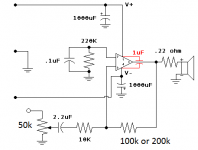Hello, my web search for LM1875 based circuits found one design by Sijose:
????(sijosae) - [DIY] LM1875 Gain Clone
I did not want to post schematic without his approval. I remember him from Headwize forum. I did search for his project on this forum, but with no avail. But, I noticed some members were interested in LM1875 based headphone amp. What do you think? Is it worth of trying?
????(sijosae) - [DIY] LM1875 Gain Clone
I did not want to post schematic without his approval. I remember him from Headwize forum. I did search for his project on this forum, but with no avail. But, I noticed some members were interested in LM1875 based headphone amp. What do you think? Is it worth of trying?
I did search for his project on this forum, but with no avail.
I know this has been dealt with on Diyaudio, and I also remember the thread on Headwize (too bad its gone...).
Try this:
http://www.diyaudio.com/forums/headphone-systems/62828-lm3875-headphone-amp-another-try.html
You easily should be able to apply that on the LM1875...
Hello, my web search for LM1875 based circuits found one design by Sijose:
????(sijosae) - [DIY] LM1875 Gain Clone
I did not want to post schematic without his approval. I remember him from Headwize forum. I did search for his project on this forum, but with no avail. But, I noticed some members were interested in LM1875 based headphone amp. What do you think? Is it worth of trying?
***Careful with inverted gainclones and input pots!***
Gainclone needs a gain of at least 10 to be guaranteed stable. All gains are negative because ... it's inverting.
Here's a generic inv gainclone:

The input pot becomes part of the gain setting network. Gain isn't just 100k/10k because there's more than 10k that the inv input 'sees' (looking back from the inv input).
With the pot at half way (worst case for this problem) it looks like two 25k resistors in parallel to the inv input. So in total that's 10k plus two 25k in parallel or a total of 22.5k
100k/22.5k = 4.4! Way less than gain of 10!
200k feeback res:
200k/22.5k = 8.8! Cutting it too close!
And larger pots make it worse!
100k pot looks like two 50k in parallel so inv input sees 10k plus 25k = 35k
200k/35k= 5.7
100k/35k = 2.8
Learned through ... bad experience a decade ago!
Even of gains of 10, the very learned and wize-in-the-way-of-the-gainclone, AndrewT says:
the gain is almost at the minimum that National recommend. I think you would see quite a bit of overshoot on faster signals when so much of the signal is fed back.
The reduced feedback when using gains set to between 25 to 30times gives more accurate reproduction of the input signal. This is why many builders say they prefer a gain of 28times to other gains they have compared.
http://www.diyaudio.com/forums/headphone-systems/62828-lm3875-headphone-amp-another-try-2.html
There are ways of doing a low gain inv gainclone but in involves some sophisticated manipulation of the feedback network (lead-lag).
Cheers,
Jeff
Last edited:
- Status
- This old topic is closed. If you want to reopen this topic, contact a moderator using the "Report Post" button.